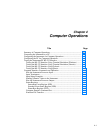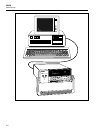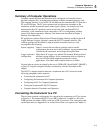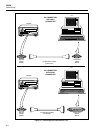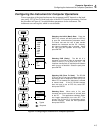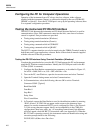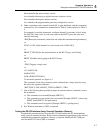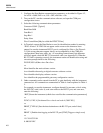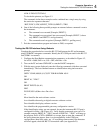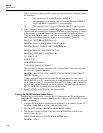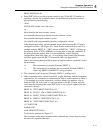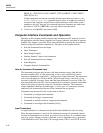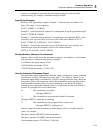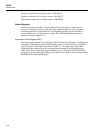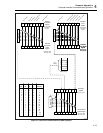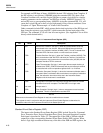
Computer Operations
Testing the Instrument/PC RS-232 Interface
4
4-9
ALM:15 DIO:255 TOTAL:0
To decode the printout, see Figure 5-3.
The commands in the above example can be combined into a single entry by using
the semicolon separator character:
*RST;FUNC 0,VDC,4;PRINT_TYPE 0,0;PRINT 1;*TRG.
6. One of the following three possible prompts are returned when a command is sent to
the instrument:
=> The command was executed [Example, PRINT 1].
!> The command was recognized, but not executed [Example, PRINT 3, where
only PRINT 0 and PRINT 1 are legal entries].
?> The command wasn’t recognized [Example, PRITN 1, spelling error].
7. Exit the communications program and return to DOS, as required.
Testing the RS-232 Interface Using Gwbasic
Complete the procedure below to test the RS-232 link between the PC and instrument
using GWBASIC interpreter commands. Identify the PC COM port used for the RS-232
link (COM1 is assumed).
1. Configure the Data Bucket communication parameters, as described in Figure 4-2,
for bAUd = 9600, PAR = no, CtS = OFF, and Echo = On.
2. Turn on the PC and enter GWBASIC to start the BASIC interpreter.
3. With the entry screen displayed, enter the following commands (which are executed
immediately). The last command returns an identification string and execution
prompt:
OPEN "COM1,9600,N,8,1,CS,CD" FOR RANDOM AS #1
OK
PRINT #1, "*IDN?"
OK
PRINT INPUT$ (46, #1)
IDN?
FLUKE,2635A,0,Mn.n An.n Dn.n Ln.n
=>
Mn.n identifies the main software version.
An.n identifies the analog-to-digital converter software version.
Dn.n identifies the display software version.
Ln.n identifies the programmable gate-array configuration version.
If the identification string was not returned, be sure the instrument RS-232 port is
configured for Echo = On (Figure 4-2). Verify that the commands were exact. For
example, entering PRINT #1, "*IDN" instead of PRINT #1, "*IDN?" will hang up
the program. Press <CNTL><BREAK> to escape, then re-enter the commands. If
the wrong characters appear, there is an incompatibility in the COM port
configurations (baud rate, parity, etc.). If everything seems normal, but characters
still don’t appear, check the RS-232 connection cable (see Appendix D).



